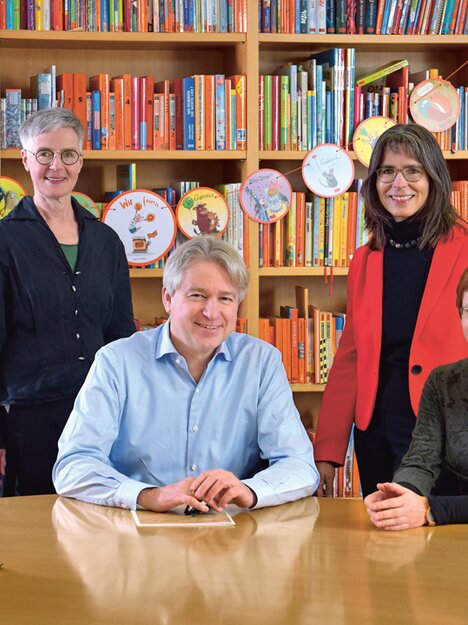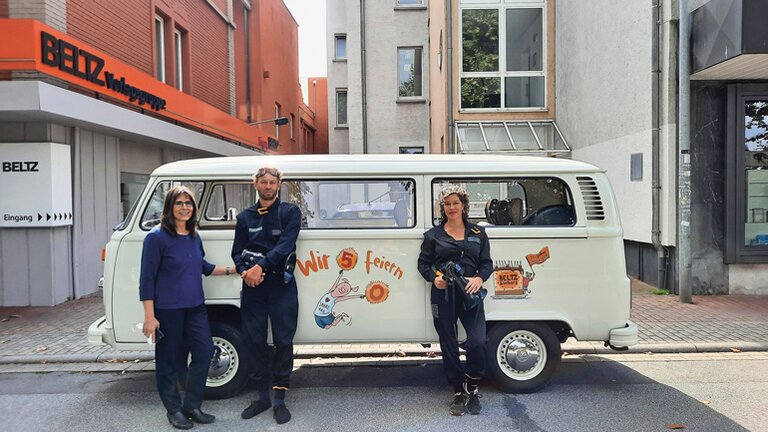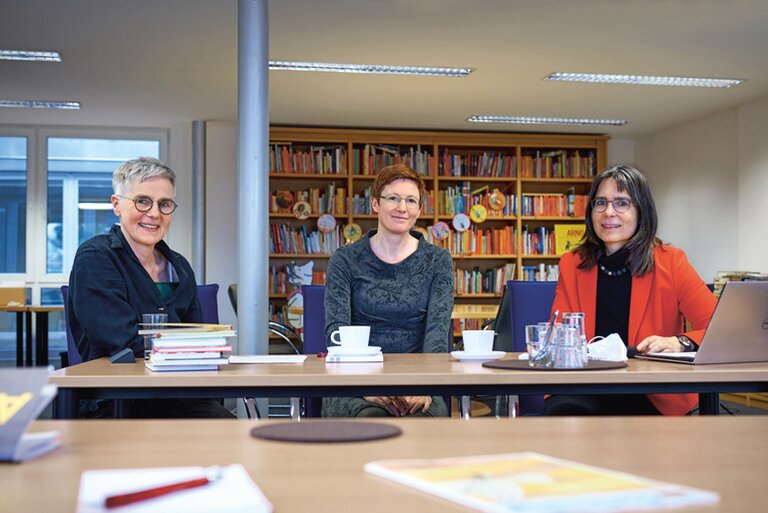Marianne Rübelmann, Petra Albers and Franziska Schiebe

J.B. Beltz & Gelberg’s 50th anniversary and Gulliver’s 35th anniversary both fell during the second summer of the pandemic. How did that make you feel? To what extent were you able to put your plans into action?
M.R. Of course, we still tend to look at the 180 years we’ve been publishing as a whole. But it’s great to see Beltz & Gelberg at 50 – this imprint was the big innovation in those 180 years. It also brings us the highest revenue in the publishing group today.
P.A. It was clear right away that we couldn’t throw a big publishing party with all our authors, and that we needed to think of something that would create a bit of profile while allowing people to maintain a safe distance. So we came up with the idea of the ‘Anniversary Bus’, which toured the country, stopping in to see our authors and readers.
Gelberg wanted to make a statement – my father was supportive of that
J.B. Looking back at Beltz & Gelberg’s early years – weren’t children’s books something of an anomaly within the publishing house at first?
P.A. I wouldn’t say they were an anomaly. After all, this wasn’t just the founding of a publisher – it was the founding of a publisher in the context of an ex- isting printing house, and was a logical extension given its rapidly expanding educational programme.
P.A. I wouldn’t say they were an anomaly. After all, this wasn’t just the founding of a publisher – it was the founding of a publisher in the context of an existing printing house, and was a logical extension given its rapidly expanding educational programme.
M.R. Ultimately, it all turned on a happy encounter between my father, Dr Manfred Beltz-Rübelmann, and Hans-Joachim Gelberg at a book fair, where Mr Gelberg approached my father and said that he had a few ideas. My father liked starting new projects, which is how our psychology programme came about later as well. He met Frank Schwoerer (long-time publisher at Campus Verlag) at a book fair, too – and they got going after that. The agreement was: one brings in the capital, the other the ideas, and they were a great team for many years.
J.B. A chance encounter at a book fair with farreaching consequences …
M.R. Yes, combined with my father’s overall interest in developing the company – moving forward and growing Beltz both financially and in terms of its scope.
J.B. When you think of the subjects covered – like ecology and sex education – there was obviously a strong sense of mission …
P.A. Hans-Joachim had a literary background. He always said that if you can write for adults, you can write for children too. He talked to all the authors. And society was ready for these kinds of subjects. Non-fiction was less his cup of tea, but he took up their themes in literature, with authors like Christine Nöstlinger, Leonie Ossowski and others.
J.B. Biographies were an important building block within the publishing programme for young adults.
P.A. Yes, the idea of a series featuring people’s life stories was prompted by the memory of the Nazi book burnings, and the idea that those authors and texts needed to be revived. Hans-Joachim did this quite pragmatically: he only published the biographies of figures who were no longer alive, so that he could avoid copyright issues. And that resulted in an extensive series of short texts in brochure form – because the books needed to be affordable to reach a large audience. That was the concept.

J.B. You’ve managed to turn a number of authors’ works into real classics. That’s an extraordinary strength.
M.R. Perhaps in part because schools really liked our authors and their books are still read in schools today.
P.A. Yes, that’s also an exceptional feature of our publishing house: we hold on to rights for a long time. It’s become more difficult today because you have to sell a certain number of books annually, so that the book somehow supports itself. We can’t hold on to every title by Peter Härtling or Klaus Kordon anymore, but a lot has to happen before we relinquish the rights. We have a really nice publishing history with Erwin Moser. He was very successful, then other authors came along, Moser fell ill, and he couldn’t write anything new. His books began to slip into discount territory. But we managed to rebuild his profile; we re-edited his works, because there’s so much depth to his stories. And it’s taken almost a generation for those who grew up with him and remember him positively to have kids of their own. We’ve seen this with Janosch and with Moser, and you need to have that patience and then to judge the right moment. For Moser, that moment is now, because he has a certain calmness about him and gets how you can see the big picture in small details. That’s just mindfulness by another name.
J.B. I think that’s a really nice way of putting it. So you work more like an agent with the authors and develop them. Have you also sold his works abroad?
P.A. Yes, lots – and very quickly to Japan. He fits so well into Japanese culture with its visual language, those very simple lines.
J.B. Is holding on to authors a typical German quality or more of a Beltz quality?
J.B. You’ve managed to turn a number of authors’ works into real classics. That’s an extraordinary strength.
M.R. Perhaps in part because schools really liked our authors and their books are still read in schools today.
P.A. Yes, that’s also an exceptional feature of our publishing house: we hold on to rights for a long time. It’s become more difficult today because you have to sell a certain number of books annually, so that the book somehow supports itself. We can’t hold on to every title by Peter Härtling or Klaus Kordon anymore, but a lot has to happen before we relinquish the rights. We have a really nice publishing history with Erwin Moser. He was very successful, then other authors came along, Moser fell ill, and he couldn’t write anything new. His books began to slip into discount territory. But we managed to rebuild his profile; we re-edited his works, because there’s so much depth to his stories. And it’s taken almost a generation for those who grew up with him and remember him positively to have kids of their own. We’ve seen this with Janosch and with Moser, and you need to have that patience and then to judge the right moment. For Moser, that moment is now, because he has a certain calmness about him and gets how you can see the big picture in small details. That’s just mindfulness by another name.
J.B. I think that’s a really nice way of putting it. So you work more like an agent with the authors and develop them. Have you also sold his works abroad?
P.A. Yes, lots – and very quickly to Japan. He fits so well into Japanese culture with its visual language, those very simple lines.
J.B. Is holding on to authors a typical German quality or more of a Beltz quality?
M.R. I’d say we definitely like to hold on to things. To people, to authors. We want to go on a journey together, and to play a guardian role as well.
P.A. You’ll see the same in other children’s publishers who’ve been around for a long time. Younger publishing houses simply don’t have the backlist. These publishers might not even get the chance to build up a stable of authors and illustrators anymore, because they now publish with lots of different publishers simultaneously.
J.B. Is loyalty to publishers lacking?
P.A. It’s an economic issue. Even we find that it’s increasingly difficult to have illustrators working exclusively for us. If we manage to create something unique with authors and illustrators, something that could only be realised at Beltz & Gelberg, then we’ve already achieved a great deal. And we pull that off pretty well.
J.B. I think it’s always helped for authors to be given a clear credit.
F.S. Yes, then you have a clear reference point in the marketplace.
P.A. I’m quite certain that Axel Scheffler is in that category. And that he sees it the same way. I’d say we definitely like to hold on to things. To people, to authors. We want to go on a journey together, and to play a guardian role as well.
P.A. You’ll see the same in other children’s publishers who’ve been around for a long time. Younger publishing houses simply don’t have the backlist. These publishers might not even get the chance to build up a stable of authors and illustrators anymore, because they now publish with lots of different publishers simultaneously.
J.B. Is loyalty to publishers lacking?
P.A. It’s an economic issue. Even we find that it’s increasingly difficult to have illustrators working exclusively for us. If we manage to create something unique with authors and illustrators, something that could only be realised at Beltz & Gelberg, then we’ve already achieved a great deal. And we pull that off pretty well.
J.B. I think it’s always helped for authors to be given a clear credit.
F.S. Yes, then you have a clear reference point in the marketplace.
P.A. I’m quite certain that Axel Scheffler is in that category. And that he sees it the same way.
Primary goal is still safeguarding our independence
J.B. When you look back over the entire 180 years – how have you managed the balancing act between tradition and innovation?
M.R. I think it’s wonderful to have a tradition, so that you can invest in innovation and the future. The fact that this publishing house has already experienced and overcome so many setbacks gives us a composure that lets us work very calmly. What we really value is the independence we’ve maintained all these years. That’s extremely important to us. It’s the reason why we recently brought a new generation of the family into the business. We didn’t want to be the old partners sitting around a table making decisions at some point. We won’t fragment the family business; people are welcome to get involved, but there’s no obligation. The primary goal is still safeguarding our independence, even seven generations down the line.
J.B. COVID-19 has brought about a push in digitalisation, especially in schools. How has this affected your strategy? Are apps still an area you’re interested in?
F.S. Our apps (such as the ‘Wörterfresser’ app) were flagship projects. We’ve always said that reading and reading aloud, which of course has an emotional dimension, is our focus. Compared to children’s books, there’s much more pressure to digitise in other publishing sectors. The e-commerce sector has developed significantly in the COVID-19 era. Our kids’ story books are particularly dependent on booksellers’ recommendations, and we have to try to compensate for that, whether it’s through social media or on a more technical level through Search Engine Optimisation.
J.B. Do you feel that podcasting has relevance for you?
F.S. We had a podcast channel during the pandemic, because we knew our platforms were going to be reduced and wanted to introduce our authors to readers. Anyone in the podcast business knows how difficult it is if you don’t have really big names. And the truth is that 50% of a podcast budget has to be spent on marketing alone.
P.A. The pandemic has really digitised our target group. Parents buying books have arrived in the digital era, due to home schooling, for example. We’re thinking a lot about the knock-on effects of this. It’s not a question of how good the content is, but rather how something we currently do exclusively in book form can be presented differently and possibly digitally. Which age groups, which parents and teachers are interested in certain types of content? These issues are coming at us faster than we could ever have imagined back in 2018.
J.B. In the end, it’s about stories. If you look at a development like the Toniebox, now successful throughout Europe – these things work thanks to their particular touch and feel. Have you also sold rights to Tonie?
P.A. Yes, Martin Baltscheit’s Geschichten vom Löwen (Lion Stories) was the first Tonie figure, so we were indirectly involved. It’s a fantastic idea, and everyone underestimated it with typical book industry arrogance. In the past, you’d have got annoyed when a bestseller went to another publisher. Now you have to get up to speed with other formats as well. We got our ‘Warrior Cats’ series out as audiobooks very quickly. That was really worthwhile – we immediately had good sales. You have to do that kind of thing fast now. In the past, we’d have thought it over for far too long.

J.B. Earlier, you mentioned a book on sustainability from the 1970s. Now you have the ‘100% Naturbuch’ (Nature Book) series. Is that paying off for you?
M.R. What I don’t want at our printing works or here at the press is greenwashing – ‘buying our way out’ through certification, while we publishers end up throwing away thousands of books still in their plastic wrappers. We have certification for our printing operations in Bad Langensalza and we pay a great deal for that, but this needs to be just a starting point rather than our goal. Our goal must be to work in such a way that we use as little electricity and as few chemicals as possible. What helps – and we do this too – is using green electricity. But publishers are still using chemistry to make books more appealing to consumers – through lamination, for example – and that’s where we have to make changes. But we do think about how to produce each and every product in the most eco-friendly way.
P.A. The problem is that we produce more than we sell, because we have to maintain a certain level of stock for bookshops, traders and so on, which ultimately may not be sold. That means we’re always working with a certain rate of returns. A print-on-demand system isn’t feasible. We can afford the nature books because we’ve now sold so many rights that we can do large print runs.
J.B. A sign that it’s the right way to go.
P.A. Our nature series is truly pioneering. But the crucial point is that customers have to be willing to pay more. What people want and what they’re willing to pay are sometimes miles apart. We have relatively affluent customers, but they still check the price.
J.B. I think customers are willing to spend more for quality.
F.S. There are certain price limits for children’s books, such as a typical birthday present, which shouldn’t cost more than 10 € – and that’s also the absolute upper limit for school books. But yes, the whole sector finally has to start raising its prices.
J.B. Publishers are on the front line of expectations about identity and diversity policies. I’d be interested to hear your experiences in that respect.
P.A. It’s a big area. We look carefully at every title, but we don’t ‘modernise’ our classics. There was a case involving a Christine Nöstlinger book. I discussed it with her daughters and we came to the conclusion that Nöstlinger wouldn’t have changed the passage herself, so we left it as it was. And it subsequently wasn’t a problem. With Janosch, there was an instance a while back where the protagonist’s paw was at the same height as a woman’s chest, and we left that as it was too. We don’t just pay attention to the text, but to the images as well. Because illustrators have to learn to show diversity, too. You can’t just give a face a different colour.
J.B. ‘Sensitivity readers’ – is that an issue for you?
P.A. We had a book due out next year read by someone of the relevant sexuality. They alerted us to something very important that we hadn’t been able to spot ourselves. But ultimately the publisher has to decide – even if opinions sometimes differ.
J.B. Many thanks to you all for the interview

About
Marianne Rübelmann has been Managing Director of the Beltz publishing group since 2005.
Petra Albers assumed responsibility for the Beltz & Gelberg and Gulliver publishing programmes the same year.
Franziska Schiebe, who has been with the company since 2013, is head of marketing and sales for Beltz.


